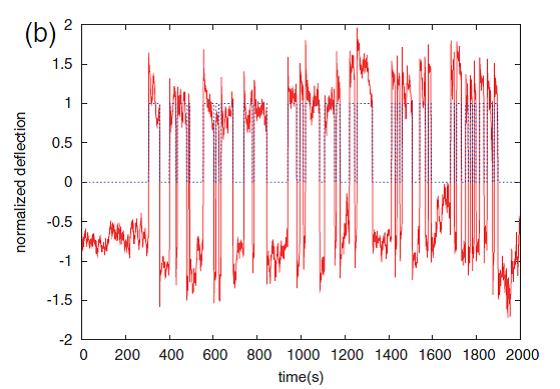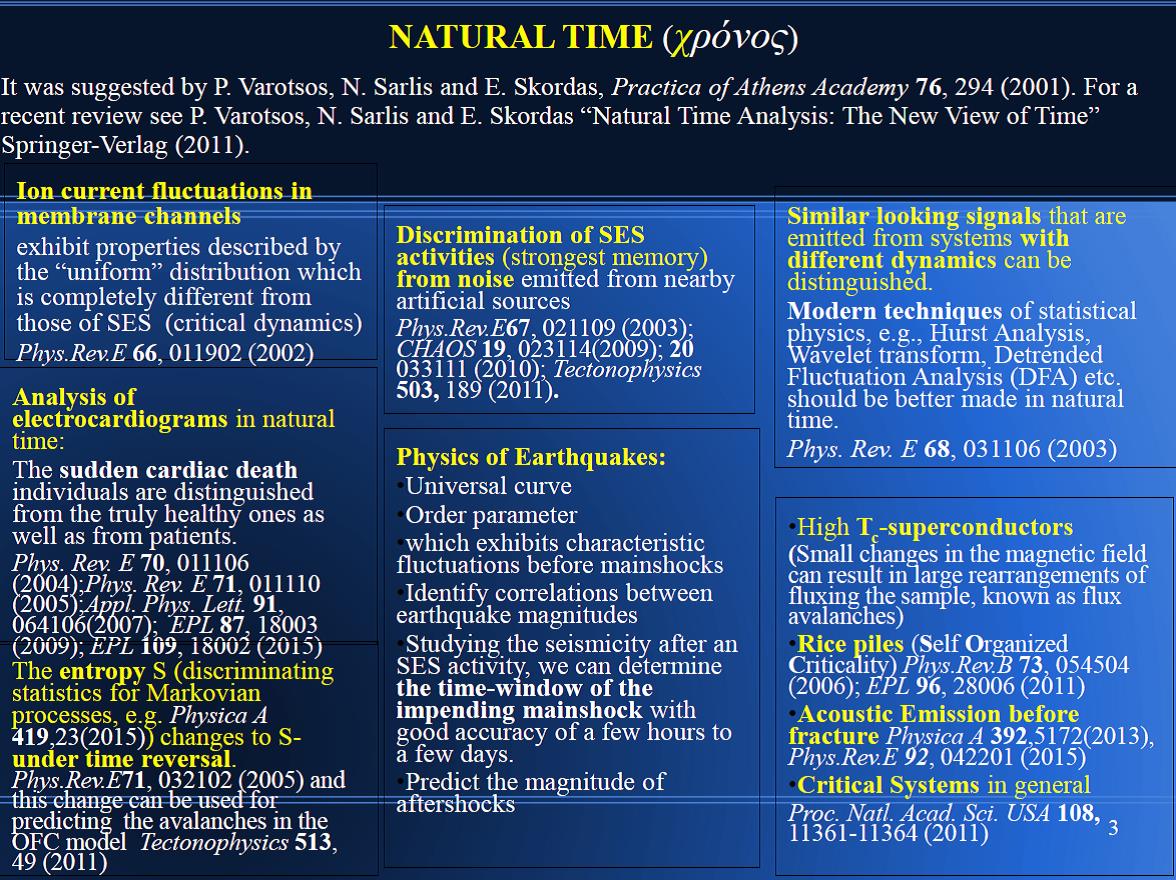Achievements during the last 15-years

The main achievement of the recent period is the extension of the applications of the new Time Domain, termed natural time. This new concept of time was first introduced by P. Varotsos, N. Sarlis and E. Skordas, Practica of Athens Academy 76, 294-321, 2001; Phys. Rev. E 66, 011902, 2002 and was followed by several papers published mainly in Physical Review and Physical Review Letters. In particular, it has been found that novel dynamical features hidden behind time series in complex systems can emerge upon analyzing them in the new time domain of natural time, which conforms to the desire to reduce uncertainty and extract signal information as much as possible. The analysis in natural time enables the study of the dynamical evolution of a complex system and identifies when the system enters a critical stage. Hence, natural time may play a key role in predicting impending catastrophic events in general. Relevant examples of data analysis in this new time domain have been recently presented in a variety of fields including Biology, Earth Sciences and Physics.
First, in Cardiology, natural time analysis of electrocardiograms: Sudden cardiac death (SCD) is a frequent cause of death and may occur even if the electrocardiogram seems to be strikingly similar (in conventional time) to that of a healthy individual. Upon employing, however, the entropy defined in natural time, SCD can be clearly distinguished from the truly healthy individuals [P. Varotsos et al., Phys. Rev. E 71, 011110 (2005)]. In addition, when considering the entropy change under time reversal, not only the risk can be identified, but also an estimate of the time of the impending cardiac arrest is provided [P. Varotsos et al., Appl. Phys. Lett. 91, 064106 (2007)]. Finally, a simple evolution model in natural time has been presented that exhibits the 1/f behaviour. The results of this model are consistent with a progressive modification of heart rate variability in healthy children and adolescents [N. Sarlis et al., EPL 87, 18003 (2009)].
Second, in Earth Sciences, the study of the low frequency geoelectrical changes, termed Seismic Electric Signals (SES), that precede major earthquakes has attracted an intense international interest: Their generation mechanism, in the focal area of a (future) earthquake, has been suggested [see P. Varotsos, The Physics of Seismic Electric Signals (TerraPub, Tokyo, 2005) and references therein] to be governed by critical dynamics. This has been confirmed since it was recently shown [P. Varotsos et al., CHAOS 19, 023114 (2009)] that SES measured during the last fifteen years exhibit scale invariance over five orders of magnitude and considering that criticality is always accompanied by fractality.
Third, in Seismology, the determination of the time of an impending major earthquake is of chief importance. Natural time enables such a determination since it can identify when a complex system approaches a critical point. We considered that earthquake scaling laws are usually interpreted as phenomena associated with the approach to a critical point and that the detection of an SES activity signifies that the system enters in the critical regime. Thus, the following procedure has been proposed: The time series of the small earthquakes that occur after the SES detection until the main shock should be analyzed in natural time. We found that the variance of natural time becomes equal to 0.070 (which manifests the approach to the critical point) a few days to one week before the main shock. This has been ascertained to date for several main shocks in Greece [P. Varotsos et al., Phys. Rev. E 73, 031114 (2006); Phys. Rev. E 74, 021123 (2006)] and Japan [S. Uyeda et al., J. Geophys. Res. 114, B02310 (2009)].
Fourth, in Statistical Physics, upon employing natural time analysis, a striking similarity of fluctuations in equilibrium phenomena and non-equilibrium systems emerges. In particular, the worldwide seismicity as well as that of the San Andreas fault system (California) and Japan have been analyzed. An order parameter for seismicity has been proposed and its fluctuations relative to the standard deviation of the distribution were subsequently studied. It was found [P. Varotsos et al.,. Phys. Rev. E 72, 041103 (2005)] that the scaled distributions fall on the same curve, which exhibits over four orders of magnitude features similar to those in several equilibrium critical phenomena (e.g., two-dimensional Ising model) as well as in non-equilibrium systems (e.g., three dimensional turbulent flow).
Fifth, in the Physics of Complex Systems, a challenging point when analyzing data from such systems that exhibit scale invariant structure is the following: In several systems, this non trivial structure points to long range temporal correlations; in other words, the self-similarity results from the process’ memory only (for example the fractional Brownian motion). Alternatively, the self-similarity may solely result from the process’ increments infinite variance (heavy tails in their distribution). In general, however, the self-similarity may result from both these origins. It has been shown [P. Varotsos et al., Phys. Rev. E 74, 021123 (2006)] that a distinction of these two origins of self-similarity, which is a difficult task, can be in principle achieved by employing the natural time analysis. For example, the self-similarity of SES solely comes from infinitely ranged temporal correlations [P. Varotsos et al., Phys. Rev. E 73, 031114 (2006)], while in the original earthquake data both origins of self-similarity (i.e., temporal and magnitude correlations in this case) are present [N. Sarlis et al., Phys. Rev. E 80, 022102 (2009)].
Sixth, in Condensed Matter Physics, the data of the avalanches of the penetration of magnetic flux into thin films of type II superconductors were analyzed in natural time and found to obey conditions (as far as the variance and the entropy in natural time is concerned) consistent with critical dynamics [N. Sarlis et al., Phys. Rev. B 73, 054504 (2006)]. In addition, natural time analysis has been applied to other systems that exhibit the so called self organized criticality (SOC). For example, studying the avalanches in a three dimensional pile of rice getting progressively closer to the critical state conform to the features suggested, on the basis of natural time, to describe critical dynamics. The emergence of criticality in such systems has been also treated in natural time including the case of recent generalized stochastic SOC models (e.g., A. Carbone and H.E. Stanley, Physica A 340, 544 (2004)).
